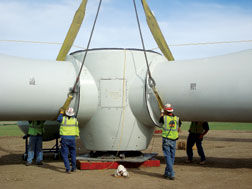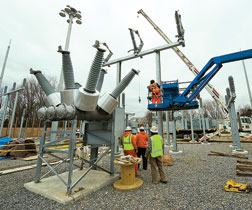 Mortenson Construction Almost 6,000 MW of wind energy projects are under construction across the U.S.
|
Top contractors in the U.S. will continue to be busy over the next few years building conventional powerplants fired by natural gas and coal. But now it appears likely they also will be laying the groundwork for nuclear plants as well.
An increasing number of contractors, anticipating a shift to greener sources of electricity, are branching out into renewable energy projects, including wind farms, biomass-fired plants and solar projects. While it may be several years before renewables provide a substantial share of the nation’s electricity needs, few doubt that day is coming.
Between 2005 and 2007, wind ranked second to natural gas in the amount of new capacity added in the U.S and the same is likely in 2008, says the American Wind Energy Association. Last year, wind-farm developers and utilities added 5,249 MW of wind capacity, bringing the nation’s total to more than 18,000 MW. About 5,700 MW of wind capacity is currently under construction, according to AWEA.
The future role that wind may play in the U.S. power industry has grabbed the public’s attention again and again this year. In May, a report by the Dept. of Energy concluded it is technically feasible for 300,000 MW of wind farms to be operational in the U.S. by 2030, enough to enable the nation to secure 20% of its electricity from wind that year.
In July, former Vice President Al Gore called for the U.S. to depend entirely on renewable energy sources by 2018. Although that goal is not likely to be realized by 2018, clearly change is afoot. “We expect to see continued growth” in wind and other renewable projects over the next several years, says Elling Olson, director of business development for M.A. Mortenson Co., which has installed more domestic wind capacity than any other contractor.
Growth in the wind sector is being driven by several factors, including the federal production tax credit, which provides a key financial incentive, and state renewable portfolio standards, which require utilities to secure increasing shares of their electricity from renewable sources.
Mortenson got an early start in the renewables market with a 1995 contract for a small wind project in Iowa, says Olson, adding his firm has been involved in more than 50 wind projects totaling more than 5,000 MW. “We installed about one-third of the wind capacity added in the U.S. last year,” Olson says. Other firms with significant shares of the domestic wind market include Wanzek Construction Inc., Fargo, N,D.; D.H. Blattner & Sons Inc., Avon, Minn.; and White Construction Inc., Clinton, Ind.
Wanzek’s flourishing wind-farm business grew out of its experience in heavy industrial construction and heavy lifting and rigging, says Jason Kaufman, the company’s vice president of business development.
Wanzek earlier in this decade installed a few individual wind turbines, found the challenge to be well within the company’s abilities, “then took a gamble in 2003 by purchasing a Manitowoc 2250 crane” that enabled it to take on larger-scale jobs, Kaufman says.
Wanzek also bought more big-lift erection cranes; it now has six. “Owning the cranes and not just leasing them enables us to control our schedule,” and ensure that cranes are available when and where they are needed, he says. Last year, the company installed 600 MW of wind turbines, and this year it expects to install at least 800 MW.
Among Wanzek’s current projects is Edison Mission Energy’s 150-MW Goat Mountain wind farm near Robert Lee, Texas. Wanzek already has completed the 80-MW first phase of the wind farm, which consists of 80 1-MW turbines, and is now finishing the 70-MW second phase, which will consist of 29 2.4-MW turbines.
Transmission Lines
With wind-farm projects now costing more than $2 million per MW, the more than 5,000 MW of wind capacity being built each year adds up to an annual $10-billion-plus market. But wind turbines are just part of the equation.
 Black & Veatch Transmission systems need bolstering, and new lines are needed to bring alternative power to population centers.
|
Because almost all of the nation’s best wind resources are located in relatively remote areas—especially the swath from Minnesota to West Texas—the wind-farm boom is spurring billions of dollars in related work for new high-voltage transmission lines to deliver wind power to population centers.
On July 17, in a move lauded by renewable-energy advocates, the Public Utility Commission of Texas (PUCT) approved a record-shattering $5-billion plan to add more than 2,300 miles of new 345-kV transmission lines in West Texas and the Texas Panhandle. The lines, which will be designed and built over the next five years, will be capable of carrying more than 18,000 MW of wind power—three times the amount currently in operation in Texas.
PUCT is expected to decide by the end of next year which companies will be responsible for building which transmission-line segments. Those companies then will determine which contractors will actually construct the lines. Each of the major projects will likely be valued at tens of millions of dollars, according to the agency.
Just to the north, a transmission-line-development joint venture of Columbus, Ohio-based American Electric Power and Des Moines, Iowa-based MidAmerican Energy Holdings this summer announced plans for two $500-million-plus, 765-kV transmission projects aimed at supporting wind-farm development. The first is in Kansas with Westar Energy and the other in Oklahoma with Oklahoma Gas & Electric.
Biomass and Solar
Two other major elements of the nation’s booming renewable-energy sector are biomass-fired powerplants and utility-scale solar projects.
Juno Beach, Florida-based FPL Energy is the nation’s leading renewable-energy company, with more than 5,400 MW of wind capacity and 148 MW of solar capacity. It has applied to the California Energy Commission for permission to build a 250-MW parabolic-trough solar plant in the Mojave Desert, and has identified sites for several hundred megawatts of additional solar capacity in the Southwest. The Mojave project will assemble more than 500,000 parabolic mirrors to receive and concentrate solar energy to heat a special fluid to produce steam, which will be used to power a turbine-generator.
FPL Energy’s sister company, electric-utility Florida Power & Light, in July secured Florida Public Service Commission approval for three solar projects of its own, including a 75-MW solar-thermal plant and solar-photovoltaic plants of 25 MW and 10 MW. Taken together, the three plants will cost more than $600 million. FP&L awarded a contract to SunPower Corp., San Jose, Calif., to build the photvoltaic plants. SunPower will supply the solar equipment and plans to have several smaller contractors assist in construction.
Several utilities also are seeking to mitigate greenhouse-gas emissions by contracting to purchase the output of large-scale biomass-fired plants. Progress...
 Related Links:
Related Links:
Post a comment to this article
Report Abusive Comment